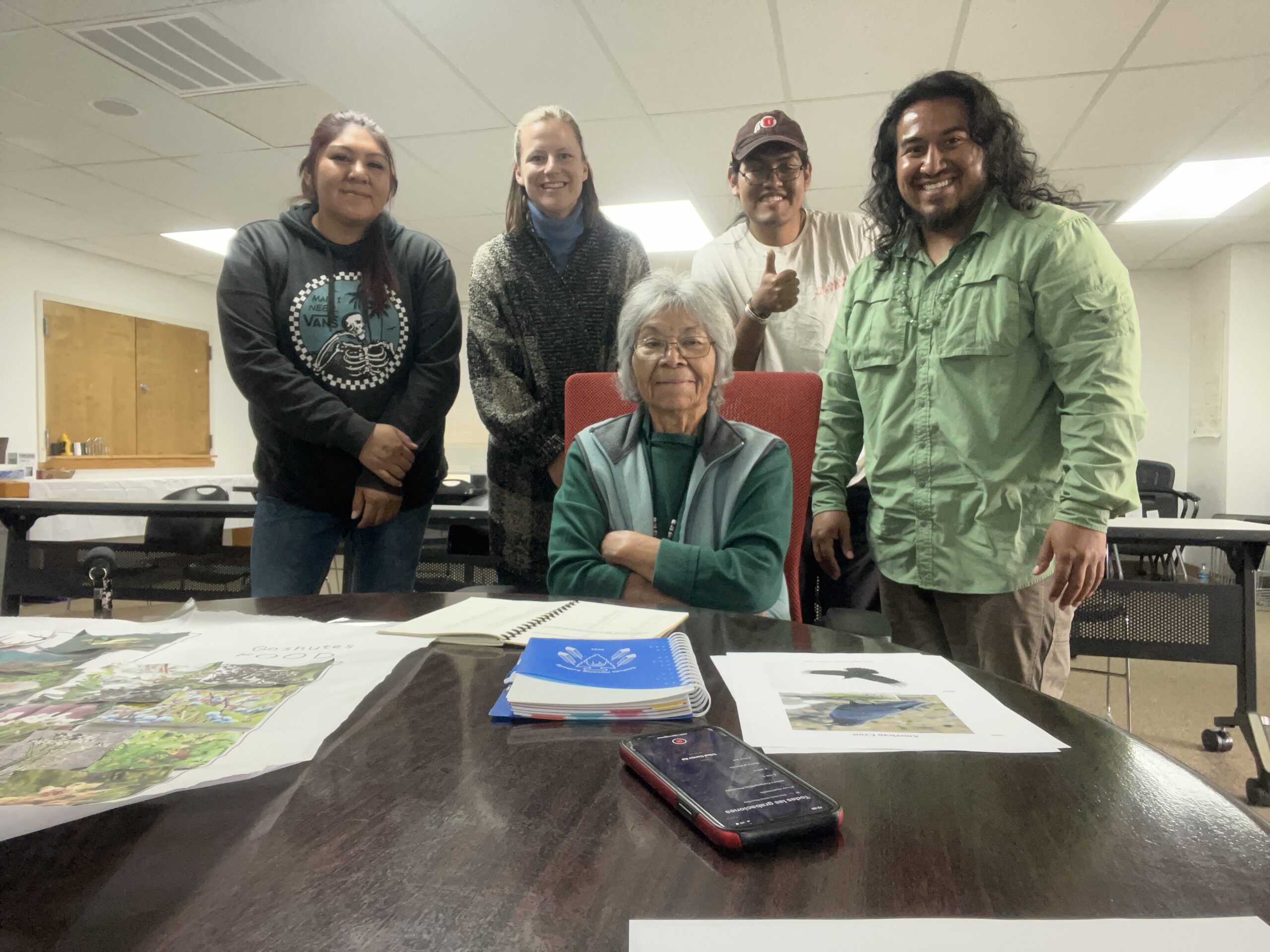Newe (Goshute) Ecological Knowledge with Genevieve Fields and Marjle Greymountain-Pete

Center: Genevieve Fields. Back Row Left to Right: Marjle Greymountain-Pete, Marissa Beckström, Isiah Cambridge and Arcia Tecun (Daniel)
By Arcia Tecun
Newe is what Goshutes call themselves, which means ‘person’ or in other words ‘the people’. Shoshone also call themselves Newe or Neme, which has the same meaning in their unique expressions of a shared language. The English words used to identify Indigenous peoples are entangled with modern colonial history and having an outsider influence. The origins of the word Goshute is a bit ambiguous and has included a variety of spellings, including ‘Goshute, Goshen Utes and Goshautes’. These are likely mispronunciations of Kusiutta, which according to Dennis R. Defa is derived from Kutsip or Kuttuhsippeh, which means ashes, desert or dry earth. Based on this one can consider that ‘desert people’ is a possible meaning or origin for Goshute. The late chairperson of the Confederated Tribes of the Goshute Reservation Rupert Steele shared in the We Shall Remain the Goshute Documentary that, “I definitely think of that word as the only one that would relate, Kuttuhsippeh, that means the ashes from a dried pool of water, that we raise from the ashes. In that respect I have a strong relationship to that word”.
I had the opportunity to go visit the Confederated Tribes of the Goshute Reservation at the end of April representing myself as Wīnak (Mayan in diaspora), as a west sider living in Soonkahni, and as the cultural director of Tracy Aviary and the Nature Center at Pia Okwai. I was privileged to be able to go together with Nuuch/Diné Nature Center Host Isiah Cambridge, and Svensk descended director of the Nature Center at Pia Okwai Marissa Beckstrom. We had the opportunity to meet with two incredible Newe (Goshute) knowledge holders and leaders who were very gracious in sharing some of their wisdom with us.
Genevieve Fields has been working for her tribe for over fifty years! She is an incredible person and knowledge keeper who has been involved in nurturing and passing on cultural and linguistic experience and wisdom for over half a century. She is the cultural advisor and tribal historic preservation officer for the Confederated Tribes of the Goshute Reservation. The video below includes Genevieve sharing names and pronunciations of several local non-human animal relatives and plants along with some Newe perspectives and practices.
Marjle Greymountain-Pete is an environmental and water specialist, and serves on many committees for the Confederated Tribes of the Goshute Reservation, including the education committee. Marjle has been working for her tribe for over a decade now! In the video below she shares some of her experience and perspective working with paa (water) and serving her Indigenous nation’s community.
These films are now publicly available. The process of this project included asking permission to film, compensation and gifting, waiting for the films to be viewed by Genevieve and Marjle so they could approve the edits I made to the footage we took during our visit, and providing them with a copy. I appreciate your patience with the background noise which is a rain storm that progressively became more intense and consistent during our visit. You can watch and listen to what Genevieve and Marjle shared with us below:
Marjle Greymountain-Pete
Genevieve Fields
Some notes on language:
Newe Taikwa or the Goshute/Shoshoni language is in the Central Numic branch which is largely spoken across the Great Basin, and it is part of the larger Uto-Aztecan language family. There are several orthographies or spellings for Newe Taikwa (the people’s language), which is often referred to as the Shoshone or Shoshoni language. There is currently not a shared standard spelling or orthography across all Newe peoples and their contemporary Indigenous nations, so you may encounter a range of different spellings. Newe Taikwa collectively holds a range of dialects, variations and pronunciations to a generally shared language that is mostly mutually intelligible. I am using one of several spelling systems known as the Miller orthography in the glossary below. This glossary includes the Newe words that were shared in the video of Genevieve Fields. The words below identify some non-human animal relatives and plants in Newe, a Goshute version of the language:
Piakwi’naa = Eagle
Huittsaan = Sage Hen
Kwitawoyon = Magpie
Pihaa Mottuhnaatsi = Hummingbird
Teheya = Deer
Peyen = Duck
Painkwi = Fish
To’nampih = Chokecherry
Kunukki = Elderberry
Tepa = Pinenuts
Waappin = Cedar Tree
Kammu = Rabbit
Tapun = Cottontail Rabbit
Kwahaten = American Antelope/Pronghorn
Pohopi = Sagebrush
Seepin = Willow
Yahan = Rock Chuck
*Aise (‘Thank you’) to the Confederated Tribes of the Goshute Reservation and especially to Genevieve Fields and Marjle Greymountain-Pete for their generosity. Special thanks as well to the University of Utah’s Environmental Humanities programme who supported this project. Muchísimas gracias también a Marissa y Isiah, por toda su ayuda y apoyo en este proyecto.
Additional references:
Chamberlin, Ralph V. 1913. Place and Personal Names of the Gosiute Indians of Utah. Proceedings of the American Philosophical Society 52,208: 1-20.
Cuch, Forrest S. History of Utah’s American Indians. University Press of Colorado, 2000.
Gould, Drusilla, and Christopher Loether. 2003. An Introduction to the Shoshoni Language. Salt Lake City: University of Utah Press.
Great Salt Lake and Great Basin Tribes: Ancestral Connection and Pathways to Repair, (30 Sep 2022), University of Utah Environmental Humanities, Retrieved from: https://www.youtube.com/watch?v=OMQRDFB8f8Q
Miller, Wick R. 1972. Newe Naekwinappeh: Shoshoni Stories and Dictionary. University of Utah Anthropological Papers, 94.
Parry, Darren. Indigenous Perspective to Climate and Environment. University of Utah Press, 2024.
University of Utah’s Shoshoni Language Project (n.d.). https://shoshoniproject.utah.edu/
We Shall Remain: A Native History of Utah, PBS Utah, 2009, Retrieved from: https://www.pbsutah.org/pbs-utah-productions/shows/we-shall-remain/